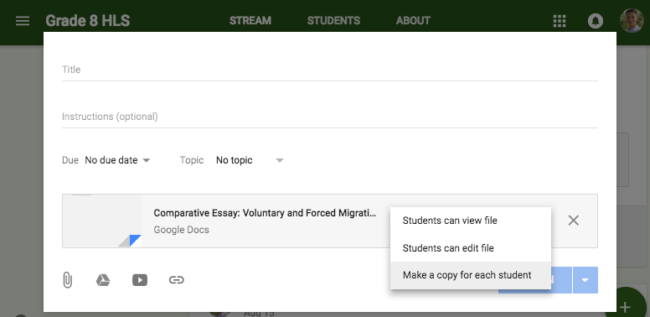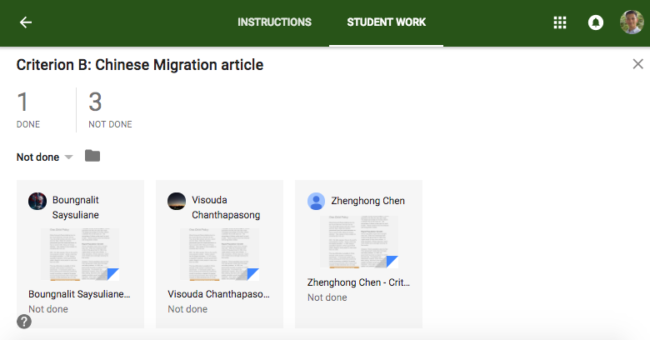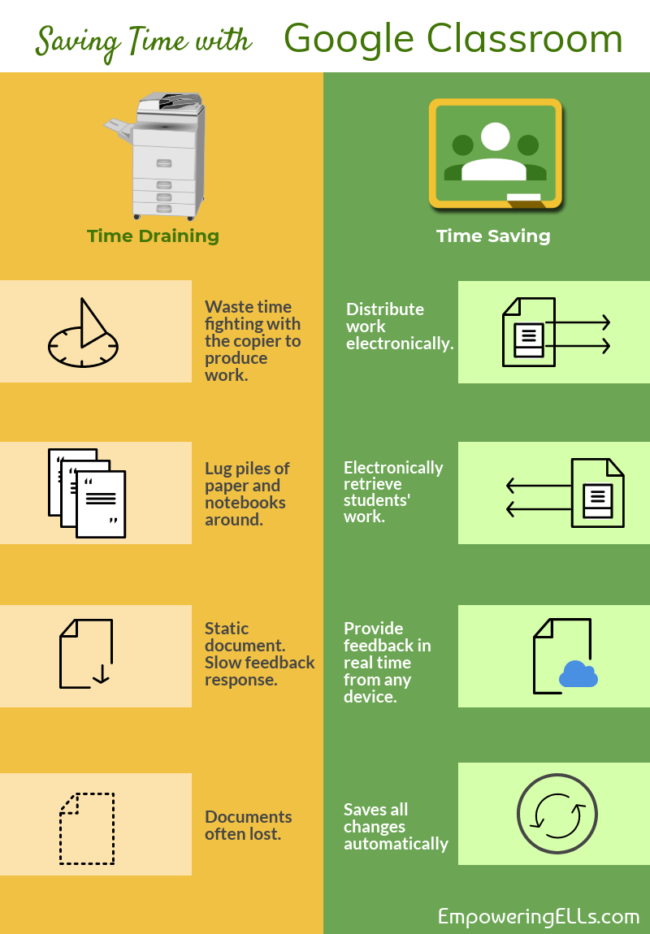If I added up all the minutes I’ve been at a photocopier printing graphic organizers for students, I bet it would be close to one month of work. This is such a significant amount of time lost that can be reallocated to much better things, such as lesson design, collaborating, or assessing students’ work.
I understand the need for colleagues in the primary school to print out work, but for secondary school teachers, there’s an alternative way to distribute resources: Google Classroom.
This article explains how teachers can use Google Classroom to give themselves more time to work with students and plan meaningful learning experiences and is Part 14 of the Transforming Instruction Through Technology series.
Sharing Resources – the Old, Time-Consuming Way
Before there were one-to-one laptop programs, this was my typical experience for creating and distributing resources to my secondary students:
- Create a graphic organizer.
- Print it out.
- Retrieve a ream of copy paper, which I had to pre-purchase.
- Rush to school by 6:30 am so I could be the first to use the copier. Being first meant a) no lines b) the copier was still working.
- Hand out glue sticks for students to glue the graphic organizers into their English notebooks, all of which I had to pre-purchase.
- Lug the notebooks home to assess students’ work.
- Lug the notebooks back to school while stopping at the copier first to make copies for today’s class.
Which way would you prefer?
Benefits of Google Classroom
Save time
The huge amount of time associated with making physical copies (moving from classroom to copier, making copies, getting paper, fixing the copier, returning to the classroom, handing out the resource to students, and collecting the assignment from students) no longer exists with Google Classroom. While we can’t eliminate the time it takes to create resources, we can save time distributing them and retrieving them from students.
To distribute the assignment to each student, I simply link it to Google Classroom and select “Make a copy for each student”. When students access the link on Google Classroom, voilà, the document is automatically created for each student WITH their names. When I want to access them, all I have to do it go into Google Classroom and select a student.

Source: Google Classroom

Source: Google Classroom
Have real-time, simultaneous access
I hear some of you saying, “Wait, we already have learning management systems (Moodle, Powerschool, Managebac, Atlas Rubicon, Dropbox, etc). We don’t need anything else.” These programs are an improvement over nothing, certainly, but they’re like one-way streets: we upload a document, which students then upload when done.
By comparison, Google Classroom is like a six-lane highway with EZ Pass. The document we give students is a living document that students and teachers can access simultaneously. No more downloading one version, editing it and waiting for a response. No more confusion over which document is the most updated or managing multiple copies of the same thing.
Each on our own devices, I often sit next to the student while we access the same document. If I need to change something about it, I can do so easily without having to go to the copier or emailing a new version. It is not only faster, it is a much easier way for students to receive real-time feedback.
Work from any device
As more and more schools are providing tablets, internet-only computers like Chromebooks, and laptops to students, more teachers can use Google Classroom to send and access students’ work.
Google can be used on any device that operates on iOS or Android. My students particularly like using their iPads or smartphones to access documents using the Google Classroom app – just be sure they have Google Docs, Slide, and Drive downloaded as well.
This means I can assess students’ work from home on any of my devices too – my personal laptop or iPad. Neither the students nor I are lugging home piles of notebooks or sheets of paper. And we love it.
Because I can view students’ work anytime even if they haven’t finished, I can gather formative data to see who needs more help through the process.
Never lose work
When I used to make class-set copies of documents, I always made a few extra because, undoubtedly, there would be a few students who would lose their documents. If students lost a piece of paper that they’ve been working on over the past few days, they had to completely start over. More time wasting. And more wasted paper.
Not with Google Classroom! Their work is always saved automatically in the cloud and filed in Google Drive. It doesn’t matter if a device is damaged or if a device accidentally shuts down because Google automatically saves everything every second. They also have excellent recovery mechanisms, which I have personally used during the rare occasion when there is a glitch on Google’s own servers.
Learn how to use Google Classroom
Have I got you interested yet? Great! Time for some practice and tutorials. There are many places to learn how to use Google Classroom, but the resource that I recommend most is Alice Keeler’s Go Slow Workshop. Keeler is the guru of all things Google Classroom, offering both a beginner’s guide to Google Classroom and even some advanced courses. Keeler also has a great book entitled 50 Things You Can Do With Google Classroom
Takeaway
I hope I’ve persuaded you to consider using Google Classroom with your students, especially teachers back in the States! They have so many demands on their limited time. It’s my hope that teachers use tools like Google Classroom to streamline the more mundane parts of their jobs (distributing and retrieving work). More time means more brain and heart space for teachers to create engaging learning experiences for students.
You already work hard. Now let technology help you work more efficiently.
If you’re interesting enhancing learning for ELs by integrating technology, please consider reading ELL Frontiers: Using Technology to Enhance Instruction for English Learners by Heather Parris, Lisa M. Estrada, and Andrea Honigsfeld. By purchasing the book, you also support this blog.


